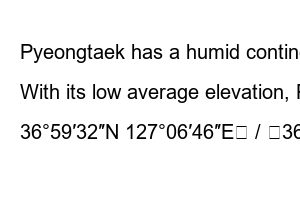평택 가볼만한곳The South Korean and United States governments came to an agreement[when?] to enlarge Camp Humphreys—a U.S. Army installation outside Anjeong-ri, a community in Pyeongtaek—and move the majority of US forces stationed in and north of Seoul to the Camp Humphreys area. Invoking eminent domain, the government obtained the surrounding land for the base expansion. This would result in the community’s third displacement from their own land since the Japanese occupation during World War II.[17]
The move originally included the headquarters of the ROK/US Combined Forces Command, which has operational control of South Korean, U.S., and U.N. combined forces during wartime. In March 2007, ROK Minister of Defense Kim Jang-soo and U.S. Secretary of Defense Robert Gates agreed to dissolve the ROK-U.S. Combined Forces Command on April 17, 2012.[18] This would allow ROK forces to have wartime control of its military during a military confrontation with the North. The ROK/US agreement allows USFK to move to one centralized location away from the congestion of Seoul and its surrounding areas. This relocation agreement results in returning two-thirds of the land currently used by the United States Military back to the South Korean government. By 2008, the U.S. military was to have consolidated 41 installations down to 10 due to the relocation agreement. USFK’s only jail facility in South Korea is at Camp Humphreys.
Osan Air Base is in Songtan, a district in Pyeongtaek.
The Korean War Monument of the South African Air Force was opened on 29 September 1975 by the Ministry of National Defense of the Republic of Korea in memory of the 37 South African Air Force members who served during the Korean War.[19][20]
Pyeongtaek has a humid continental climate (Köppen: Dwa), but can be considered a borderline humid subtropical climate (Köppen: Cwa) using the −3 °C (27 °F) isotherm.
With its low average elevation, Pyeongtaek has the warmest January average temperature in Gyeonggi Province at -4.5°C, and the hottest average temperature in August at 26.4°C. The annual average precipitation is 1,100 mm, with an average of 283.4 mm in July and 207.3 mm in August, the lowest in the province. This is due to the relatively low occurrence of orographic rainfall compared to other regions.[22]
36°59′32″N 127°06′46″E / 36.992236°N 127.112821°E / 36.992236; 127.112821

